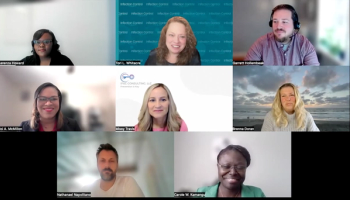
- Infection Control Today, July/August 2021 (Vol. 25 No. 6)
- Volume 25
- Issue 6
Calling All (Retired) Infection Preventionists: You’re Needed
The infection prevention department at Ascension Texas managed to shore up IP ranks by calling a couple of IPs out of retirement and asking another if she would postpone her retirement during a COVID-19 surge.
The demographic challenges facing the infection prevention field represent an almost existential threat.1 The hard question must be asked: Will the specialty dry up? Despite the crucial role IPs played in helping patients and their fellow health care professionals weather COVID-19 surges, the post–COVID-19 normal might dishearteningly resemble the pre–COVID-19 normal. IPs again may start to feel underappreciated2 and underutilized,3 while their ranks continue to thin. It’s a situation much on the minds of working IPs,4 including those who are APIC officials, as they lobby US states to mandate that NHs and other long-term care facilities hire full-time IPs, and encourage hospitals to layer the IP career path5—novice, becoming proficient, proficient, and expert—through training programs that are often tied to teaching institutions.
In the meantime, though…there’s the meantime. A study6 unveiled last month at APIC’s annual conference looked at a creative approach to keep infection prevention departments fully staffed while also giving younger health care workers who want to become IPs the training they need.
The infection prevention department at Ascension Texas managed to shore up IP ranks by calling a couple of IPs out of retirement and asking another if she would postpone her retirement during a COVID-19 surge. The 3 IPs helped with remote monitoring, thereby freeing the IPs on site to take a more hands-on approach.
“The [retired] IPs required no onboarding or training due to prior knowledge of surveillance methodology, electronic health records, and surveillance software systems,” writes study author Holly Taylor, MPH, CIC, the infection prevention director at Ascension Texas in the study. “An [as-needed] status was preferred over [full-time] or part-time status by both the IPs and the organization. Full-time IPs reported increased availability for unit-based activities.”
Taylor relates to ICT® that not only did the retired IPs help with the workload, they also helped ease new IPs into the profession. “When you are a novice coming into infection prevention, there is so much content, so much work. It’s incredibly fast-paced,” she tells ICT®. “And we know novice IPs often come in without a lot of support. The attrition rate is pretty high. So even just being able to offload some of those administrative tasks, administrative burden, to help facilitate a [better] learning environment, [was appreciated]. I’ve had feedback from my novice IPs talking about how much [the program] has given them space to learn the profession, develop competency in key areas.”
Experienced IPs also found interacting with the retired IPs to be an educational experience.
“I have one who was an endoscopy manager for an extended period of time,” says Taylor. “She brings just a really invaluable set of skills and level of expertise related to high-level disinfection of endoscopes, and so she has come in to round with folks or get perspectives and give feedback, consult with them, to help prioritize any follow-up actions, and so forth.”
Taylor hopes that the arrangement might be more than a stopgap. Ascension Texas administrators so far have made no indication that they want to end the program even as COVID-19 ebbs.
“I know that they are helping support and work through expanding the staffing complement of my department,” Taylor tells ICT®. “I see this as something that they allow me to keep for a while. I have not heard that they have put an end date on it for me at all.”
References:
- Diamond F. Infection preventionists face demographic challenges. Infection Control Today®. May 11, 2021. Accessed June 14, 2021. https://www.infectioncontroltoday.com/view/infection-
preventionists-face-demographic-challenges - Diamond F. A conversation with Kevin Kavanagh, MD: infection preventionists are underutilized and underappreciated. Infection Control Today®. December 13, 2019. Accessed June 25, 2021. https://www.infectioncontroltoday.com/view/conversation-
kevin-kavanagh-md-infection-preventionists-are-
underutilized-and-underappreciated - Diamond F. Infection preventionists marginalized in antimicrobial stewardship programs. Infection Control Today®. January 13, 2020. Accessed June 17, 2021. https://www.infectioncontroltoday.com/view/
infection-preventionists-marginalized-
antimicrobial-stewardship-programs - Diamond F. 2 infection preventionists talk about reenergizing the field. Infection Control Today®. May 11, 2021. Accessed June 23, 2021. https://www.infectioncontroltoday.com/view/2-infection-
preventionists-talk-about-reenergizing-the-field - Developmental path of the infection preventionist. Association for Professionals in Infection Control and Epidemiology. Updated 2019. Accessed June 20, 2021.
https://apic.org/professional-practice/roadmap - Taylor H. Use of retired infection preventionists to supplement infection prevention department staffing. Presented at: Annual Conference of the Association for Professionals in Infection Control and Epidemiology; June 28, 2021; remote.
Articles in this issue
over 4 years ago
What IPs Need to Know About Ventilationover 4 years ago
Let Airflow Show Pathogens the Door (or Window or Vent)over 4 years ago
College Guidance Counseling: Get the COVID-19 Vaccineover 4 years ago
CDC’s Flu Czar Says She’s Ready for the Fall Offensiveover 4 years ago
How To Reenergize the Fielfover 4 years ago
Infection Preventionists Face Demographic ChallengesNewsletter
Stay prepared and protected with Infection Control Today's newsletter, delivering essential updates, best practices, and expert insights for infection preventionists.




